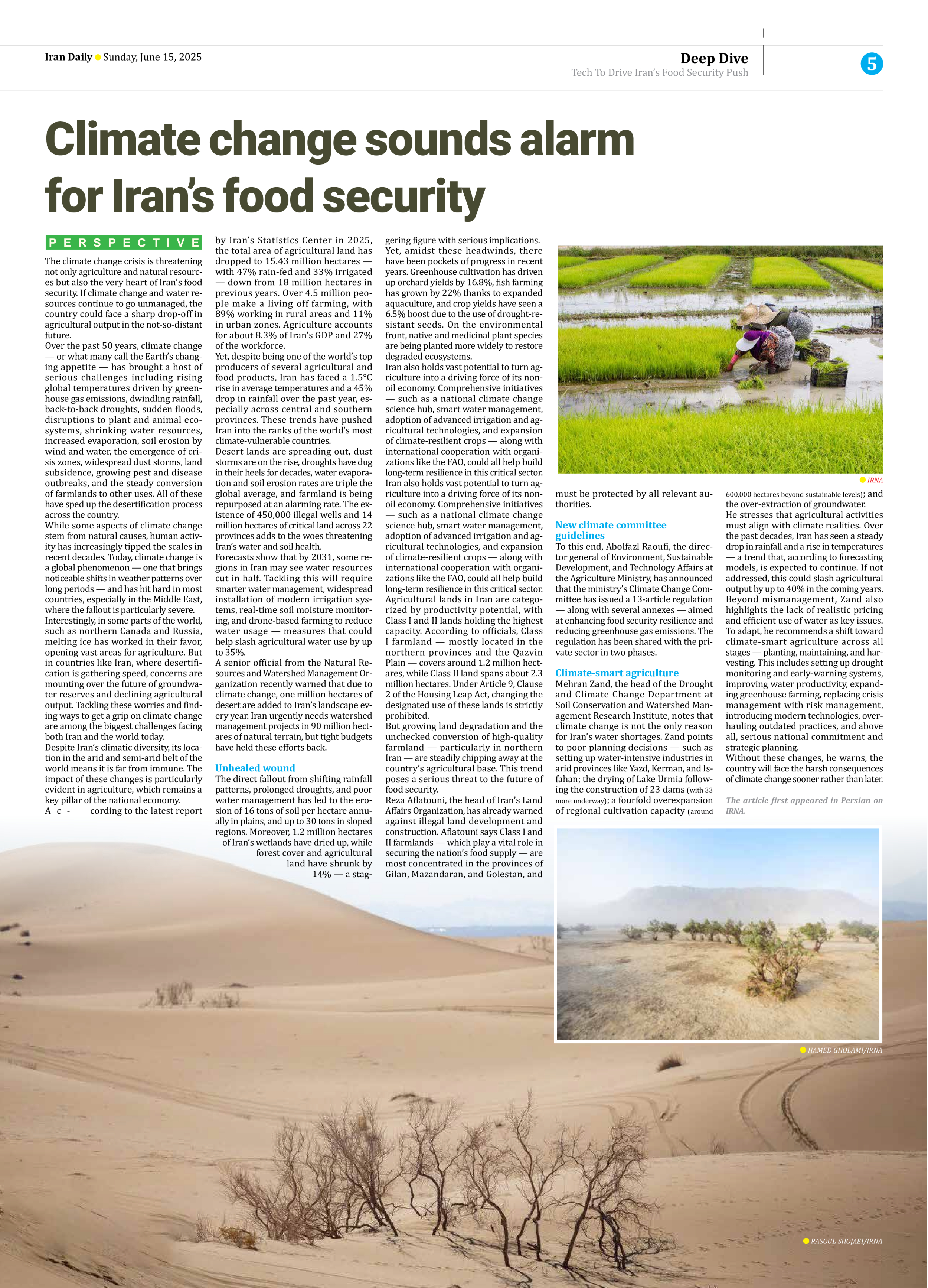
Climate change sounds alarm for Iran’s food security
The climate change crisis is threatening not only agriculture and natural resources but also the very heart of Iran’s food security. If climate change and water resources continue to go unmanaged, the country could face a sharp drop-off in agricultural output in the not-so-distant future.
Over the past 50 years, climate change — or what many call the Earth’s changing appetite — has brought a host of serious challenges including rising global temperatures driven by greenhouse gas emissions, dwindling rainfall, back-to-back droughts, sudden floods, disruptions to plant and animal ecosystems, shrinking water resources, increased evaporation, soil erosion by wind and water, the emergence of crisis zones, widespread dust storms, land subsidence, growing pest and disease outbreaks, and the steady conversion of farmlands to other uses. All of these have sped up the desertification process across the country.
While some aspects of climate change stem from natural causes, human activity has increasingly tipped the scales in recent decades. Today, climate change is a global phenomenon — one that brings noticeable shifts in weather patterns over long periods — and has hit hard in most countries, especially in the Middle East, where the fallout is particularly severe.
Interestingly, in some parts of the world, such as northern Canada and Russia, melting ice has worked in their favor, opening vast areas for agriculture. But in countries like Iran, where desertification is gathering speed, concerns are mounting over the future of groundwater reserves and declining agricultural output. Tackling these worries and finding ways to get a grip on climate change are among the biggest challenges facing both Iran and the world today.
Despite Iran’s climatic diversity, its location in the arid and semi-arid belt of the world means it is far from immune. The impact of these changes is particularly evident in agriculture, which remains a key pillar of the national economy.
According to the latest report by Iran’s Statistics Center in 2025, the total area of agricultural land has dropped to 15.43 million hectares — with 47% rain-fed and 33% irrigated — down from 18 million hectares in previous years. Over 4.5 million people make a living off farming, with 89% working in rural areas and 11% in urban zones. Agriculture accounts for about 8.3% of Iran’s GDP and 27% of the workforce.
Yet, despite being one of the world’s top producers of several agricultural and food products, Iran has faced a 1.5°C rise in average temperatures and a 45% drop in rainfall over the past year, especially across central and southern provinces. These trends have pushed Iran into the ranks of the world’s most climate-vulnerable countries.
Desert lands are spreading out, dust storms are on the rise, droughts have dug in their heels for decades, water evaporation and soil erosion rates are triple the global average, and farmland is being repurposed at an alarming rate. The existence of 450,000 illegal wells and 14 million hectares of critical land across 22 provinces adds to the woes threatening Iran’s water and soil health.
Forecasts show that by 2031, some regions in Iran may see water resources cut in half. Tackling this will require smarter water management, widespread installation of modern irrigation systems, real-time soil moisture monitoring, and drone-based farming to reduce water usage — measures that could help slash agricultural water use by up to 35%.
A senior official from the Natural Resources and Watershed Management Organization recently warned that due to climate change, one million hectares of desert are added to Iran’s landscape every year. Iran urgently needs watershed management projects in 90 million hectares of natural terrain, but tight budgets have held these efforts back.
Unhealed wound
The direct fallout from shifting rainfall patterns, prolonged droughts, and poor water management has led to the erosion of 16 tons of soil per hectare annually in plains, and up to 30 tons in sloped regions. Moreover, 1.2 million hectares of Iran’s wetlands have dried up, while forest cover and agricultural land have shrunk by 14% — a staggering figure with serious implications.
Yet, amidst these headwinds, there have been pockets of progress in recent years. Greenhouse cultivation has driven up orchard yields by 16.8%, fish farming has grown by 22% thanks to expanded aquaculture, and crop yields have seen a 6.5% boost due to the use of drought-resistant seeds. On the environmental front, native and medicinal plant species are being planted more widely to restore degraded ecosystems.
Iran also holds vast potential to turn agriculture into a driving force of its non-oil economy. Comprehensive initiatives — such as a national climate change science hub, smart water management, adoption of advanced irrigation and agricultural technologies, and expansion of climate-resilient crops — along with international cooperation with organizations like the FAO, could all help build long-term resilience in this critical sector.
Iran also holds vast potential to turn agriculture into a driving force of its non-oil economy. Comprehensive initiatives — such as a national climate change science hub, smart water management, adoption of advanced irrigation and agricultural technologies, and expansion of climate-resilient crops — along with international cooperation with organizations like the FAO, could all help build long-term resilience in this critical sector.
Agricultural lands in Iran are categorized by productivity potential, with Class I and II lands holding the highest capacity. According to officials, Class I farmland — mostly located in the northern provinces and the Qazvin Plain — covers around 1.2 million hectares, while Class II land spans about 2.3 million hectares. Under Article 9, Clause 2 of the Housing Leap Act, changing the designated use of these lands is strictly prohibited.
But growing land degradation and the unchecked conversion of high-quality farmland — particularly in northern Iran — are steadily chipping away at the country’s agricultural base. This trend poses a serious threat to the future of food security.
Reza Aflatouni, the head of Iran’s Land Affairs Organization, has already warned against illegal land development and construction. Aflatouni says Class I and II farmlands — which play a vital role in securing the nation’s food supply — are most concentrated in the provinces of Gilan, Mazandaran, and Golestan, and must be protected by all relevant authorities.
New climate committee guidelines
To this end, Abolfazl Raoufi, the director general of Environment, Sustainable Development, and Technology Affairs at the Agriculture Ministry, has announced that the ministry’s Climate Change Committee has issued a 13-article regulation — along with several annexes — aimed at enhancing food security resilience and reducing greenhouse gas emissions. The regulation has been shared with the private sector in two phases.
Climate-smart agriculture
Mehran Zand, the head of the Drought and Climate Change Department at Soil Conservation and Watershed Management Research Institute, notes that climate change is not the only reason for Iran’s water shortages. Zand points to poor planning decisions — such as setting up water-intensive industries in arid provinces like Yazd, Kerman, and Isfahan; the drying of Lake Urmia following the construction of 23 dams (with 33 more underway); a fourfold overexpansion of regional cultivation capacity (around 600,000 hectares beyond sustainable levels); and the over-extraction of groundwater.
He stresses that agricultural activities must align with climate realities. Over the past decades, Iran has seen a steady drop in rainfall and a rise in temperatures — a trend that, according to forecasting models, is expected to continue. If not addressed, this could slash agricultural output by up to 40% in the coming years.
Beyond mismanagement, Zand also highlights the lack of realistic pricing and efficient use of water as key issues. To adapt, he recommends a shift toward climate-smart agriculture across all stages — planting, maintaining, and harvesting. This includes setting up drought monitoring and early-warning systems, improving water productivity, expanding greenhouse farming, replacing crisis management with risk management, introducing modern technologies, overhauling outdated practices, and above all, serious national commitment and strategic planning.
Without these changes, he warns, the country will face the harsh consequences of climate change sooner rather than later.
The article first appeared in Persian on IRNA.







